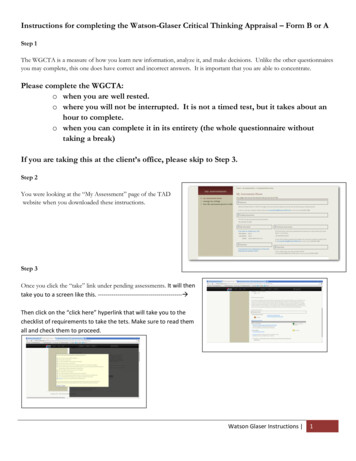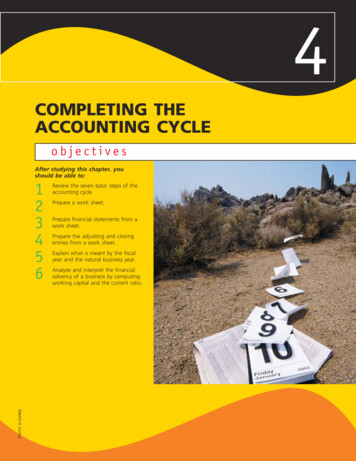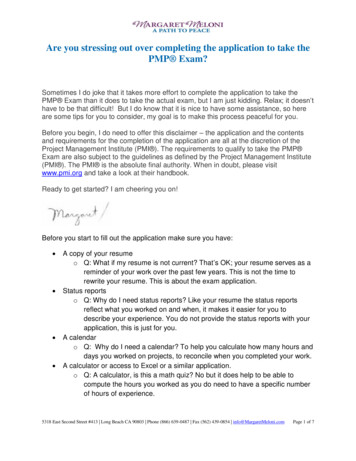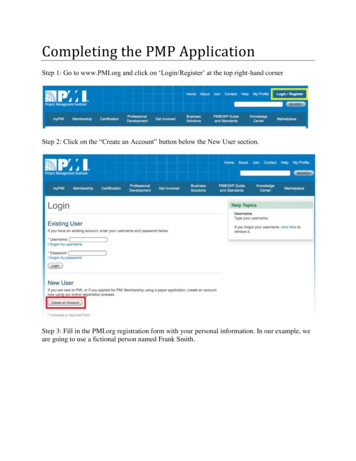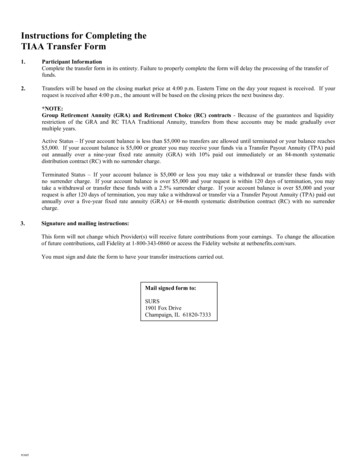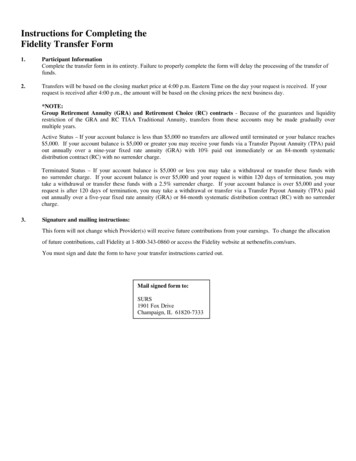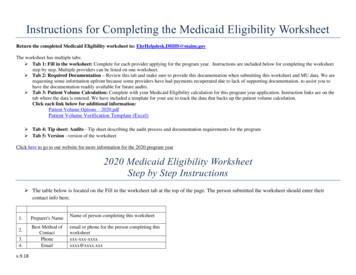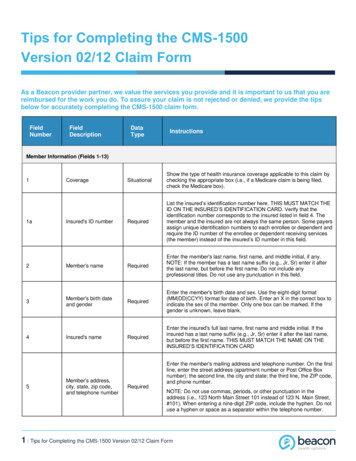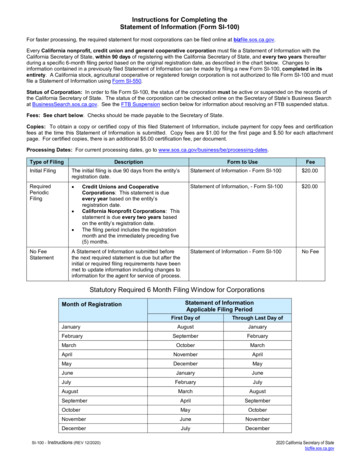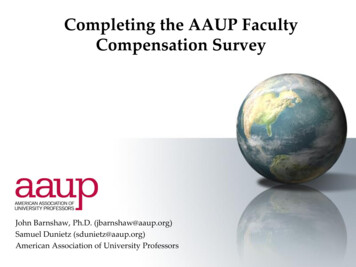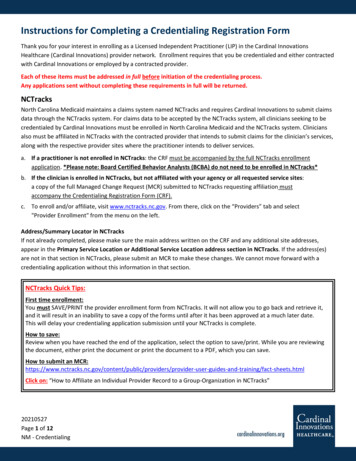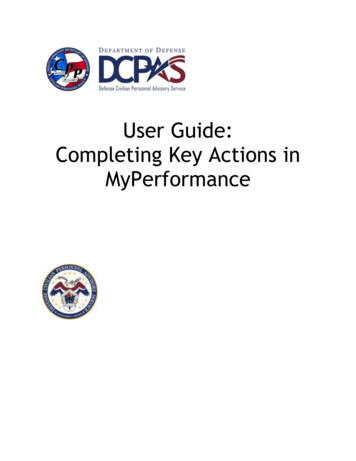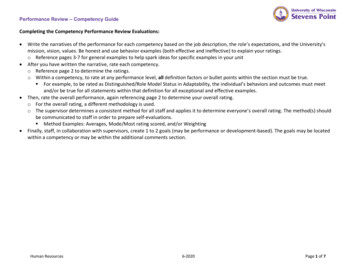
Transcription
Performance Review – Competency GuideCompleting the Competency Performance Review Evaluations: Write the narratives of the performance for each competency based on the job description, the role’s expectations, and the University’smission, vision, values. Be honest and use behavior examples (both effective and ineffective) to explain your ratings.o Reference pages 3-7 for general examples to help spark ideas for specific examples in your unitAfter you have written the narrative, rate each competency.o Reference page 2 to determine the ratings.o Within a competency, to rate at any performance level, all definition factors or bullet points within the section must be true. For example, to be rated as Distinguished/Role Model Status in Adaptability, the individual’s behaviors and outcomes must meetand/or be true for all statements within that definition for all exceptional and effective examples.Then, rate the overall performance, again referencing page 2 to determine your overall rating.o For the overall rating, a different methodology is used.o The supervisor determines a consistent method for all staff and applies it to determine everyone’s overall rating. The method(s) shouldbe communicated to staff in order to prepare self-evaluations. Method Examples: Averages, Mode/Most rating scored, and/or WeightingFinally, staff, in collaboration with supervisors, create 1 to 2 goals (may be performance or development-based). The goals may be locatedwithin a competency or may be within the additional comments section.Human Resources6-2020Page 1 of 7
Performance Review – CompetenciesCompetencies are comprised of defined knowledge, skills, and behaviors needed to be effective in one’s role, department, and institution. A competencymodel provides a guide for comprehensive measurement of overall job performance.The Performance Review – Competency model allows individuals to reflect and review prescribed competencies that are founded on UW-Stevens Pointmission, vision, and values. The below rating scale is used to determine UW-Stevens Point competency proficiency.RatingsDefinition Performance clearly and consistently exceeds all competency related expectations Performance consistently demonstrates exceptional behaviors, serves as a role model and/or mentor to others in theDistinguisheddepartment/UniversityPerformance and Performance demonstrates advanced mastery of the competencyRole Model Status Minimal development needed to maintain and stay up to date for current competency knowledge and performance Others rarely equal performance of this caliber in similar roles Performance consistently meets and often exceeds all competency related expectations Performance consistently demonstrates effective behaviors and often demonstrates exceptional behaviorsSuperior/Highly Performance demonstrates intermediate to advanced mastery of the competencyEffective Some development is suggested to maintain and stay up to date for current competency or to increase competency knowledgePerformanceand performance Performance is continually and consistently superior and regularly goes beyond what is expected Performance consistently meets most or all competency related expectations Performance consistently demonstrates effective behaviorsFully Performance consistently demonstrates basic mastery of the competency and often demonstrates intermediate mastery of theSuccessful/EffectivecompetencyPerformance Development is suggested to maintain/stay up to date for current competency or to increase competency knowledge andperformance Consistently adds value within the department for the specific competency Performance achieves some, but not all competency related expectations Performance inconsistently demonstrates effective behaviors – demonstrates some behaviors but not others, or uses behaviorsPartially SuccessfulinconsistentlyPerformance/Needs May occasionally fall below behavior or position expectationsImprovement Performance demonstrates basic proficiency of the competency Development is required to increase competency knowledge and performance Performance rarely achieves (or fails) to meet effective competency related expectationsHighly IneffectivePerformance Substantial development is required to increase competency knowledge and performanceHuman Resources6-2020Page 2 of 7
Performance Review – CompetenciesThe following tables define each competency and include examples of exceptional, effective, and very ineffective behaviors, these lists are not exhaustive.Responsibilities from the individual’s position description may also be added into the competencies to align the performance with the position description. Ifneeded, define behaviors of the responsibility in terms of very ineffective, effective, and exceptional examples. Ineffective rating for a competency is a mix ofbehaviors from very ineffective and effective examples. Highly effective rating is a mix of behaviors from exception and effective examples.CompetencyDefinitionVery Ineffective UniversityExpertise Applies theUniversity mission,vision, and valuesto work and decisionsUnderstands howthe UniversityworksActions or decisions madeare consistently not in linewith the University’smission, vision, and orvaluesDoes not take the time tolearn how things workwithin the departmentand/or UniversityPerformance or decisionsmade negatively impactcolleagues, customers,vendors, etc.Effective Role Expertise andSelf-Development Demonstrates roleknowledge, skills,and procedures Commitment togrowth anddevelopment Human ResourcesUses out of dateknowledge, skills, and toolsDoes not learn newknowledge, skills, and/ortools when requiredDoes not demonstrate awillingness to learn orapply new knowledge,skills, and/or tools to workDoes not seek feedbackand reacts negatively toconstructive feedback Considers UW-Stevens Point’s mission, vision,and values consistentlyWilling and able to get things done throughinformal and formal channelsTakes into consideration how actions anddecisions impact colleagues, customers,vendors, etc.Understands how the University works and thereasoning behind key processes and proceduresEffectively use the companies formal andinformal systems to get things doneFollows University and UW-System policiesMaintains cross-functional focus and uses themost appropriate channels to communicatewithin and between departmentsSeeks out information about other departments’functions, missions, etc.Keeps up to date on best practices affecting theposition, department, and/or UniversityTakes advantage of learning opportunitiesprovided by the department/UniversitySeeks feedback from supervisor, colleagues,customers, etc.Learns by observing more experiencedcolleaguesIdentifies and understands own strengths andthe areas of improvementDevelops own development/growth goals6-2020Exceptional Considers UW-Stevens Point’s mission,vision, and values in every decision madeand action takenCan communicate why things work the waythey do; effectively considers thatinformation in decision makingUp to date on trends/benchmarks outsideof the University and applies thatinformation to increase effectiveness in thedepartment and/or UniversityAble to bridge technical and role relatedknowledge and skills to interpersonal andmanagerial skillsExperiments with and creates newprocesses to drive improvement within thedepartment/UniversitySeeks and engages in learningopportunities outside of is provided by thedepartment/UniversityReflects on all feedback provided toimprove and applies the lessons learnedfrom past experiences to new situationsPage 3 of 7
Performance Review – CompetenciesCompetencyVery IneffectiveDefinition Produces work that isbelow quality standards,contains errors, and/oroften requires rework Doesn’t follow effectiveand accurate workprocesses (e.g. checklists,work order systems)Quality of Work Does not implementchanges to own workFocuses on workprocess whenqualityneeded/required Avoids learning new toolsand techniques to improvework processes Does not follow policies orprocedures to ensuresafety Does not prioritize work Gives up easily when facedwith obstaclesQuantity of Work Disorganized or wastesProducestimeappropriate Does not have or follow aquantity of workplanHuman ResourcesEffective Produces work that meets the needs of internaland external customersPlans own work activities in advance to insurethat all assignments are completed in a timelyand quality mannerFollows processes to ensure work is free fromerrorsUses established systems to organize andefficiently keep track of information, data, time,and resourcesImplements changes to own work openly andpositivelyApplies tools and technology effectively whenrequestedUnderstands and applies all safety standards;reports and corrects safety problemsNotices opportunities for improvements andoffers quality improvement optionsPrioritizes easily between important andunimportant work; determines project urgencyin a meaningful and practical wayEliminates obstacles when they ariseUses time effectively and efficientlyPlans work, ensures that resources are availableto complete work, and works to avoid conflictsManages multiple projects effectivelyDelegates appropriately6-2020Exceptional Consistently produces work that is alwaysamong the best qualityAnticipates and takes actions to avoidquality problemsCreates and updates effective workprocesses to ensure qualityInitiates implementing new tools andtechniques effectively for the departmentand/or UniversityCreates an environment committed toupholding safety standardsLinks individual work todepartment/University strategic goalsAnticipates obstacles, plans and takesaction to address them, shares knowledgeto help others avoid similar obstaclesAble to take on complex projects or tasksto achieve goals; uses available resourcesto complete workPage 4 of 7
Performance Review – CompetenciesCompetencyVery IneffectiveDefinition Makes decisions that impact ateam without team member’sCollaborationinput Devalues other’s knowledge,Buildskills, abilities, and/orrelationshipsideas/contributionswith colleagues, Does not provide or acceptsupervisor,feedback or does sovendors, etc.inappropriately Withholds information orContributes toexpertise from otherseffective team Creates or ignores conflictperformance CustomerServiceDemonstratescustomer serviceskills effectivelyDiversity &InclusionDevelops andensures theUniversityenvironment isequitable,inclusive,respectful, andcooperative Human ResourcesDoes not meet customer’s needsor answer their questionsDisplays poor customer serviceskills while interacting withcustomers (does not maintainpositive tone, interrupts, raisesvoice, etc.)Does not use customersatisfaction feedback toolsOnly works with individuals theyare comfortable withDoes not seek out differingviewpoints and insightsActs inappropriately with thosedifferent from themselvesIgnores compliancerequirements; does not preventor respond to inappropriate orillegal actions of themselves orothersEffective ExceptionalModels positivity, productivity, and pride inone’s workListens and responds constructively to otherteam members’ ideasExpresses disagreement constructivelyReinforces team members for theircontributionsGives honest and constructive feedback toteam members appropriatelyShares information and expertise with teammembers to help them be successfulOffers help to team membersLooks at own behavior to solve problemsversus blaming othersMeets customer needs and answersquestions correctlyResolves customer problems to the customer’ssatisfactionMaintains good customer services skills(positive tone, listens, etc.)Uses customer service satisfaction tools Seeks and uses diverse perspectives and ideasTreats all people with respect regardless ofdifferencesProvides a supportive work environment forthe multicultural workforceRecognizes differences as opportunities tolearn and gain by working togetherParticipates in diversity training opportunities;seeks to prevent inappropriate or illegalactions; reports inappropriate or illegal actionsof others 6-2020 Encourages and supports teammembers to offer ideas, ask for help,and share informationLeverages the strengths of teammembers; develops ways toimprove/strengthen team capabilitiesAnticipates and acts to addresspotential conflict situations; helpsothers to address conflict situationsHas minimal conflicts; learns fromconflict and continually appliesknowledge to avoid conflictsResolve conflicts in a positive outcomefor all versus own self-interestsPredicts customer needs and questionsand proactively provides information,services, or productsLearns from all customer servicefeedback to improve performanceand/or processesNever shows a preference for a singlegroup of people; actively reaches out toothers not part of their dailywork/team(s)Champions diversity and inclusivenessConfronts inappropriate behaviors byothersAcknowledges and challenges theexistence of systemic oppression--ofmultiple kinds--in our culture, ourinstitutions, and ourselves, and work todismantle itPage 5 of 7
Performance Review – CompetenciesCompetencyDefinitionJudgement andProblemSolvingVery Ineffective Makes soundjudgement anduses effective problem solvingto make decisions Reliability andAccountabilityIs responsible forand takesaccountability forperformance,actions, andoutcomes Human ResourcesFrequently basesconclusions or decision onlittle or no input fromothersIneffectively analyzesinformation or optionsDoes not make timelydecisionsActions do not supportdecisions made (by self orothers)Keeps information to selfthat could impact other’sdecisionsDoes not foresee orconsider impacts orconsequences of decisionsmadeDoes not set, accept, orachieve realistic and/orstretch goalsMakes incomplete orunrealistic commitmentsFrequently needs remindersto complete tasksDoes not acceptreasonability for actionsBlames others or usesexcuses for obstacles,circumstances, or resultsEffective ExceptionalIdentifies the need for a decision and gathersnecessary information and/or does researchPerformance supports decisions made (by self orothers)Foresees and reviews the impact or consequencesof decisions and then makes a decision witheffective resultsRecognizes when to escalate appropriate orspecific situations to the next level of expertiseMakes timely, informed decisions that take intoaccount the facts, goals, constraints, and risksUses logic and methods to solve difficult problemswith effective solutionsPractices objective rather than subjective reasoningand actionAssesses qualitative and quantitative informationto make decisions Sets, accepts, and achieves realistic and stretchgoalsMakes realistic commitments, objectives, and goalsFollows through consistently on commitmentsEffectively completes tasks even when obstaclesariseTakes responsibility for negative results orproblemsCompletes tasks on time and with minimalsupervision 6-2020 Sought out by others for advice ondecision-makingEncourages a supportive environmentwhere diverse views are exploredUses models and tools to improve thedecision making processServes as an advocate once a decision ismadeBalances risks and makes difficultdecisions effectivelyBalances multiple stakeholderdemands/needs to create effectiveoutcomes for all stakeholders involvedSeeks out challenging goalsSays ‘no’ to tasks/projects whenappropriateModels openness and transparency insharing informationEffectively maintains performance whenfaced with significant and/or long-termobstaclesTakes responsibility for personal andorganizational success and failuresPage 6 of 7
Performance Review – CompetenciesCompetencyDefinitionVery Ineffective AdaptabilityAccepts change Understands changesin work tasks,situations, andenvironment CompetencyDefinition Demonstrateseffective leadershipand managementknowledge and skillsFor those in a formalleadership role Very Ineffective Leadership andManagement ofTeamDisplays negativebehaviors when facedwith changeDoes not take action inthe face of uncertaintyDoes not implementnew behaviors,processes, orperformance whenneededEffective Does not provide astrategic vision for thedepartment/teamFeedback provided isinfrequent and/oravoids difficultconversationsSeldom interacts withteam; does not attemptto build a professionalrelationship withteam/departmentFocuses on the benefits of changeApplies new/updated methods, procedures,or techniques as neededMakes decisions and acts, when necessary,without having the entire picture; performseffectively under pressureAdjusts timelines, results, and expectationsappropriately to changing needsOpen to new ideas and opinions; changesbehaviors accordinglyExceptional Effective Creates department goals and expectationsthat are aligned with the University’s mission,vision, values, and prioritiesDevelops clear expectations and goals (usesSMART method) and makes adjustmentswhen neededMentors and guides direct reportsHolds individuals accountable forcommitments, behaviors, and improvementsParticipates in succession planning andleadership development effortsDelivers messages with honesty and tact;appropriate to the audienceProvides timely feedback directly andappropriatelyExceptional Human Resources6-2020Sees change as an opportunity for learningand growthProvides the ‘why’ and benefits to helpothers take on new changesActively seeks differing opinions and ideasLeads change; identifies ways to incorporatenew practices into existing frameworkProvides tools, resources, and opportunitiesfor the team to have input for and create thedepartment’s strategic visionCoaches direct reports but also recognizeswhen guidance or action is needed on theirpartActs in the University’s best interest, andputs that interest above personal gainUses leadership skills to inspire and motivateteams and individuals within the Universityversus using title to have authoritySeeks and encourages feedback from ownteam frequently; applies changes based onthat feedback to improve business results,relationships, etc.Delegates and empowers team; providesteam with the resources to be successfulFully understands team’s strengths and areasof improvement; designs teamsystems/process/roles to leverage strengthsPage 7 of 7
Performance Review – Competency Guide . Human Resources 6-2020 Page . 1. of . 7. Completing the Competency Performance Review Evaluations: Write the narratives of the performance for each competency based on the job description, the role’s expectations, and the University’s .File Size: 254KB
